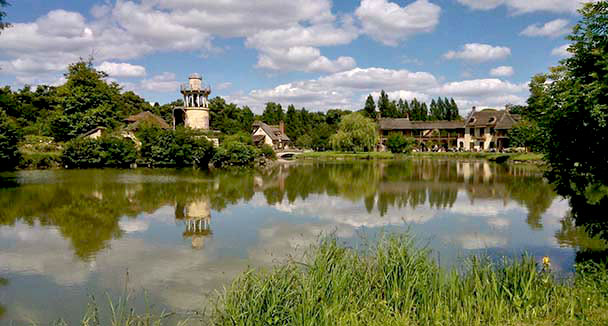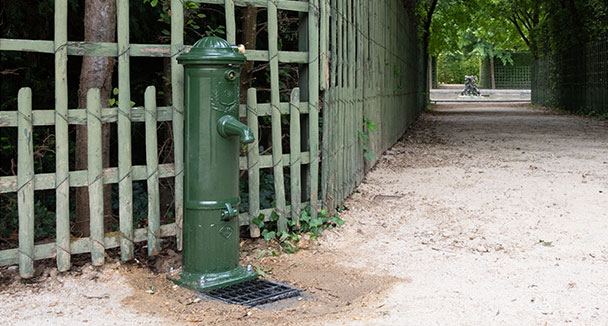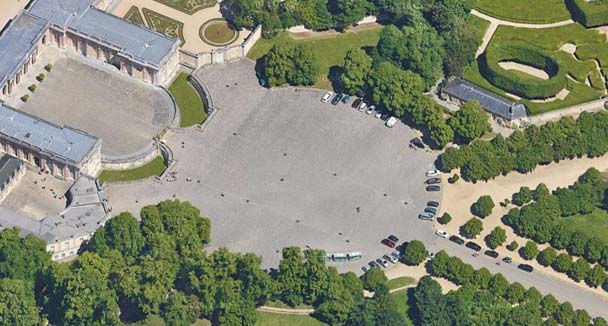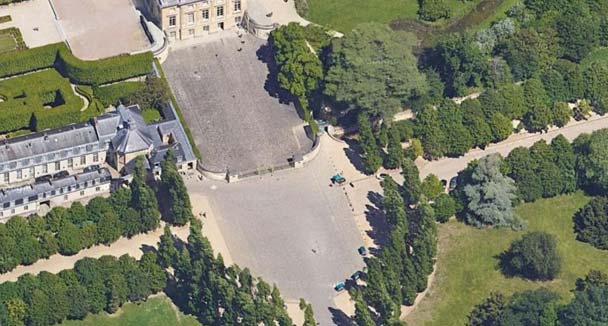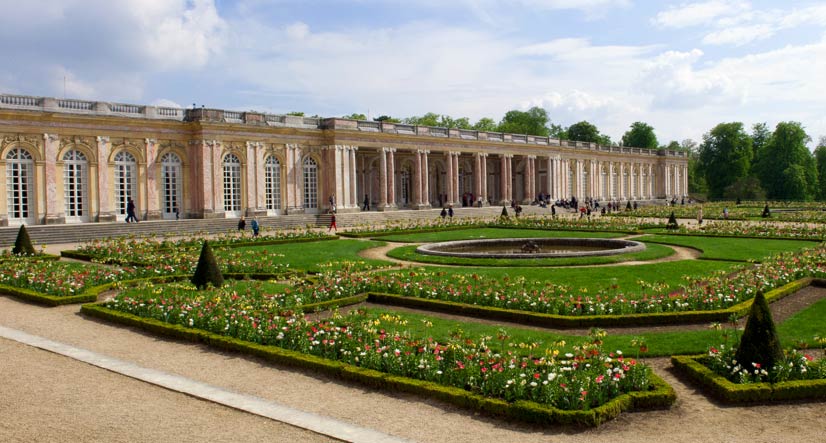Welcome to Trianon
Welcome to Trianon
The Grand Trianon
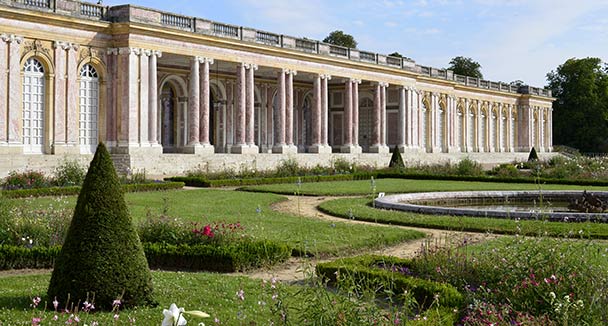
Grand Trianon Car Park
Parking is available at the parking of Grand Trianon (payable at the Queen's Gate and Saint Anthony's Gate) for cars only.
Some spaces for disabled visitors are available.
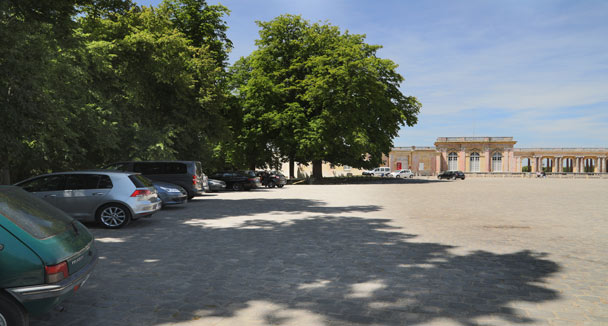
Information Point - Grand Trianon
Maps and brochures are available in the shop, beyond the security gate.
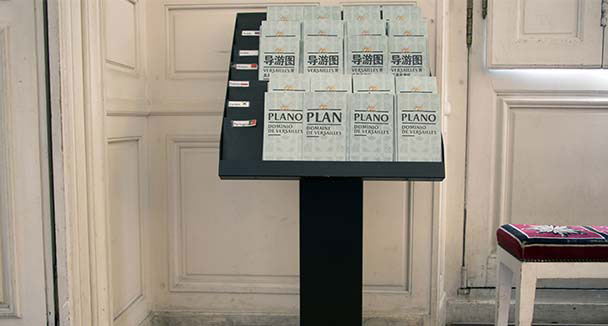
Ticket Office - Grand Trianon
The ticket office is located inside the Grand Trianon, through the archway.
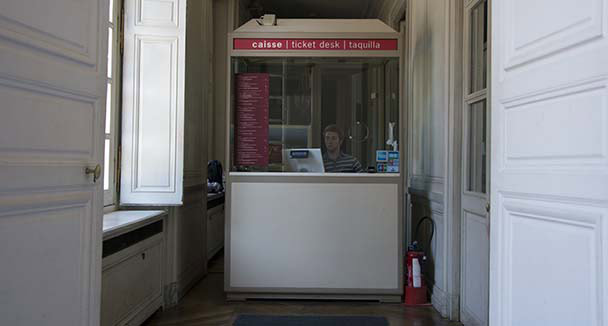
Toilets - Grand Trianon
There are free toilets in front of the Grand Trianon, inside the Chemin Creux pavilion.
In case of emergency, a defibrillator is available for public use. It is fully automatic and does not require any prior training.
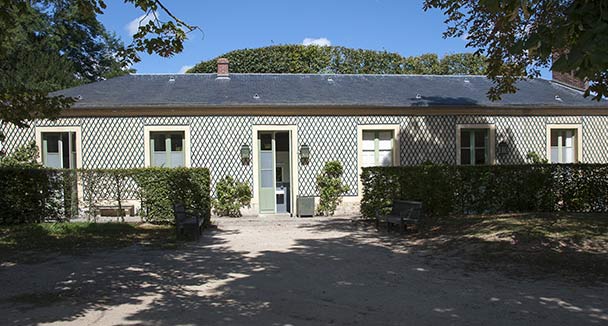
Grand Trianon Shop
The Grand Trianon shop offers a range of souvenirs, books, guides, postcards, etc. The shop is only accessible with a ticket.
Opening times: Tuesday to Sunday, 12 noon to 5pm (November to March) and 12 noon to 6pm (April to October).
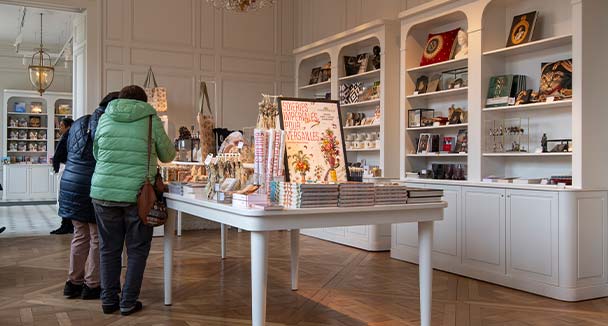
Petit Trianon
Madame de Pompadour, who wished to “relieve the king’s boredom”, was the instigator of this small palace built by Ange-Jacques Gabriel between 1763 and 1768, close to the botanical gardens and the new menagerie. To please the Marquise who was always at the height of fashion, the architect abandoned the "rocaille" style and adopted a cubist form with straight lines in accordance with the latest "Greek style" architectural trend.
Only the garden level of the Petit Trianon is accessible to disabled visitors.
The Petit Trianon is open every day except Monday. During high season, it is open from midday to 18:30 (April to October) and from midday to 17.30 during low season (November to March). In July and August, it opens exceptionally at 10am from Tuesday to Sunday. Last admission 30 minutes before closing. The gardens are open until 7:30 p.m. during high season and until 18:00 during low season.
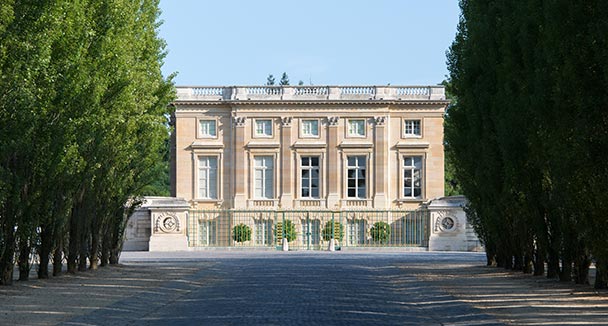
Information Point - Petit Trianon
Before the ticket kiosk is a counter with an interactive display providing information about the visit.
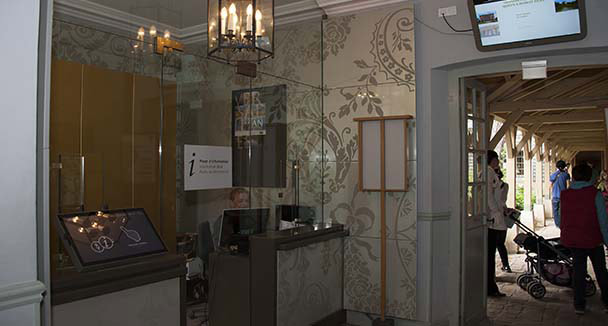
Ticket Office - Petit Trianon
The ticket office is located beyond the information desk and the courtyard.
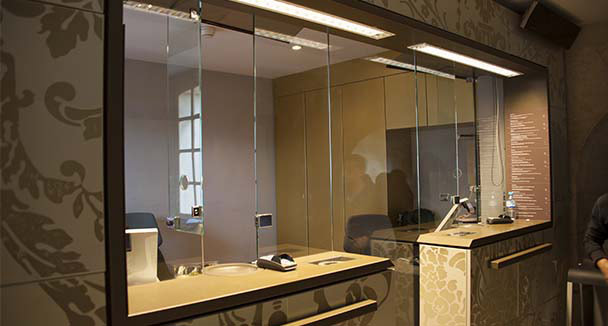
Toilets - Petit Trianon
Free toilets are located at the entrance to the Petit Trianon, beyond the information desk, in the courtyard. These toilets can be accessed without a ticket.
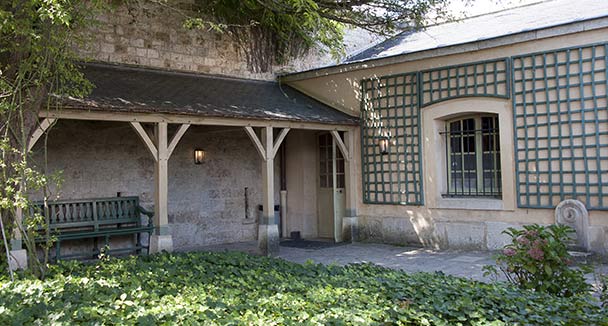
Parking - Petit Trianon (Cars)
Some spaces for disabled visitors are available.
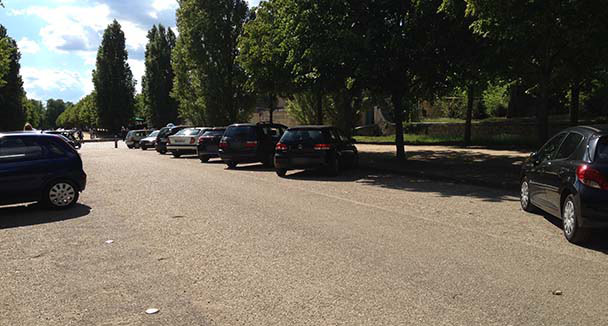
Mini Train - Petit Trianon Stop
The little train, leaving from the Petit Trianon, serves the Palace.
Return ticket to the Château: €5
It is possible to pay by credit card directly to the drivers.
Opening hours: open every day except Mondays
- January: 11:10am to 5:10pm ( January 1st : 12am to 5pm )
- February: 11:10am to 5:10pm.
- March: 11:10am to 5:10pm
- April to August : 11:10am to 6:10pm (in July and August: 10am to 6.10pm)
- September: 11:10am at 6:10pm
- October: 11:10am to 6:10pm
- November: 11:10am to 5:10pm.
- December: 11:10am to 5:10pm. ( December 25th : 12am to 5pm )
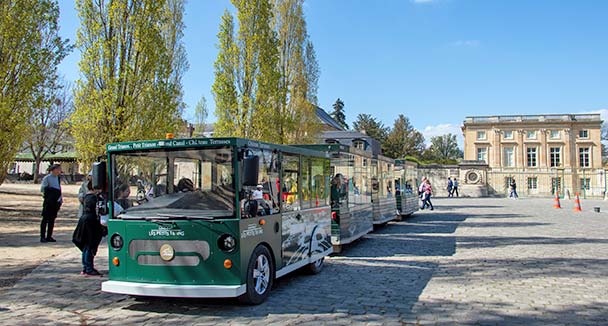
Angelina: Terrace And Take-Away Sales
Open from 12pm to 5:30 pm
The Angelina terrace offers a sweet and savoury menu to take away or to enjoy on the spot: hot chocolate, pastries, salads, sandwiches, cold drinks and home-made ice creams. Located in the Petit Trianon and accessible without a ticket, the terrace is open from Tuesday to Sunday, from 12pm to 6:30pm in high season and from 12pm to 5.30pm in low season.
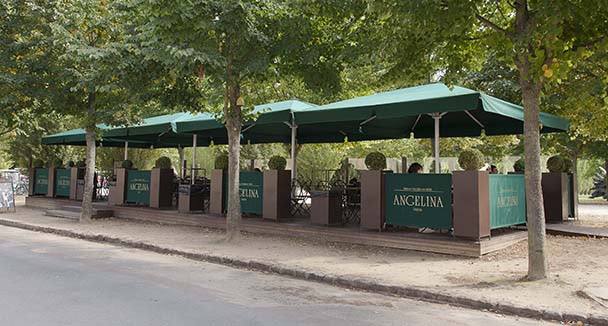
Jussieu Orangery
In 1759, at the request of Louis XV, a famous botanist called Bernard de Jussieu created a botanical garden at Trianon and had the biggest glasshouses in Europe built. Today this is called the Jussieu Orangery. With gardeners Claude and Antoine Richard, he undertook experiments on exotic or rare plants: strawberries, pineapples, tobacco, etc.
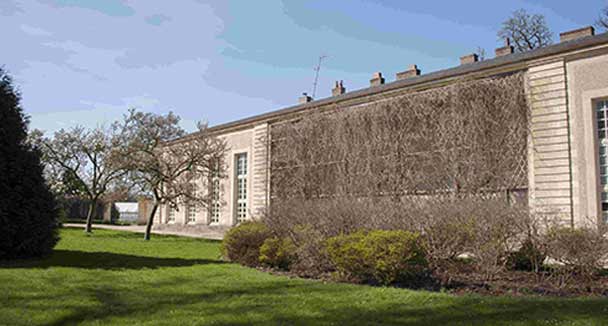
Queen’s Hamlet
Marie-Antoinette, seeking to flee the Court of Versailles, ordered the construction of her hamlet in 1783. She regularly went there to experience the charms of country life, surrounded by her lady's companions. It became a genuine farm, managed by a farmer, whose produce supplied the kitchens of the Palace.
The workshops in the Hamlet can only be viewed from the exterior.
Parking - Queen's Hamlet (Cars)
Parking is available at the Queen's Hamlet (payable at the Queen's Gate and Saint Anthony's Gate) for cars only.
Some spaces for disabled visitors are available.
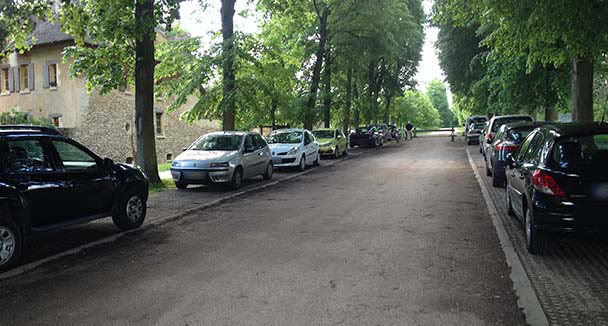
Toilets - Queen’s Hamlet
There are free toilets located in the Gardener's House, also called the Guard's house. These toilets are open from 1pm and are accessible to the disabled.
In case of emergency, a defibrillator is available for public use. It is fully automatic and does not require any prior training.
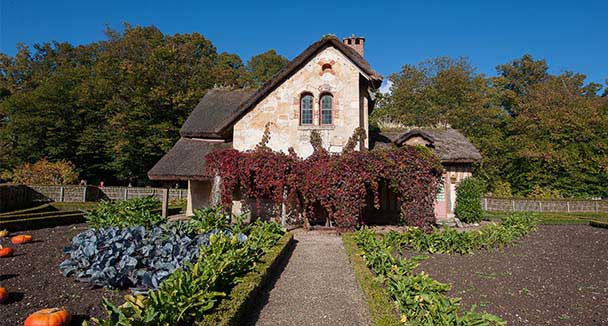
Parking - Trianon Crossroads
Parking at the Trianon Crossroads is only permitted for coaches (payable at the Queen's Gate and Saint Anthony's Gate) .
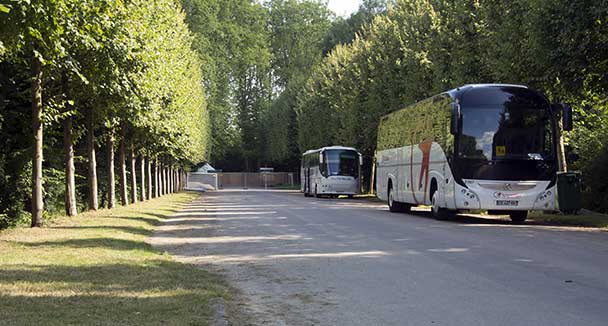
The Queen’s Gate
Vehicle access :
- Car : €12
- Bus : €30
- Montocycle : €3
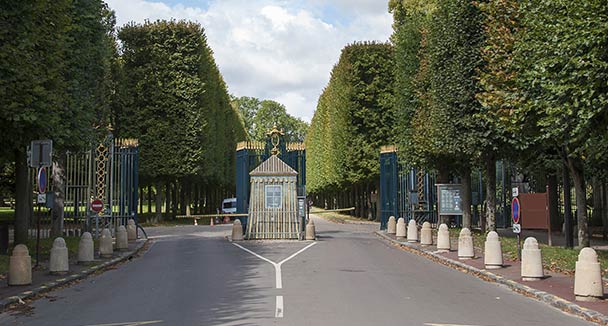
Mini Train - Grand Trianon Stop
The little train, leaving from the Grand Trianon, serves the Petit Trianon, then the Palace.
Return ticket to the Palace *: €5
* Visitors can get off at each stop and get back on the next train.
It is possible to pay by credit card directly to the drivers.
Opening hours: open every day except Mondays
- January: 11:10am to 5:10pm ( January 1st : 12am to 5pm )
- February: 11:10am to 5:10pm.
- March: 11:10am to 5:10pm
- April to August : 11:10am to 6:10pm (in July and August: 10am to 6.10pm)
- September: 11:10am at 6:10pm
- October: 11:10am to 6:10pm
- November: 11:10am to 5:10pm.
- December: 11:10am to 5:10pm. ( December 25th : 12am to 5pm )
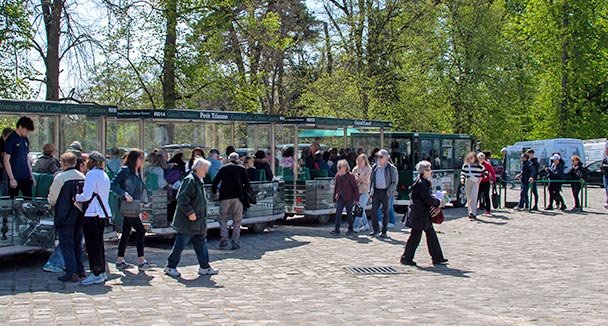
Water Sideboard Fountain
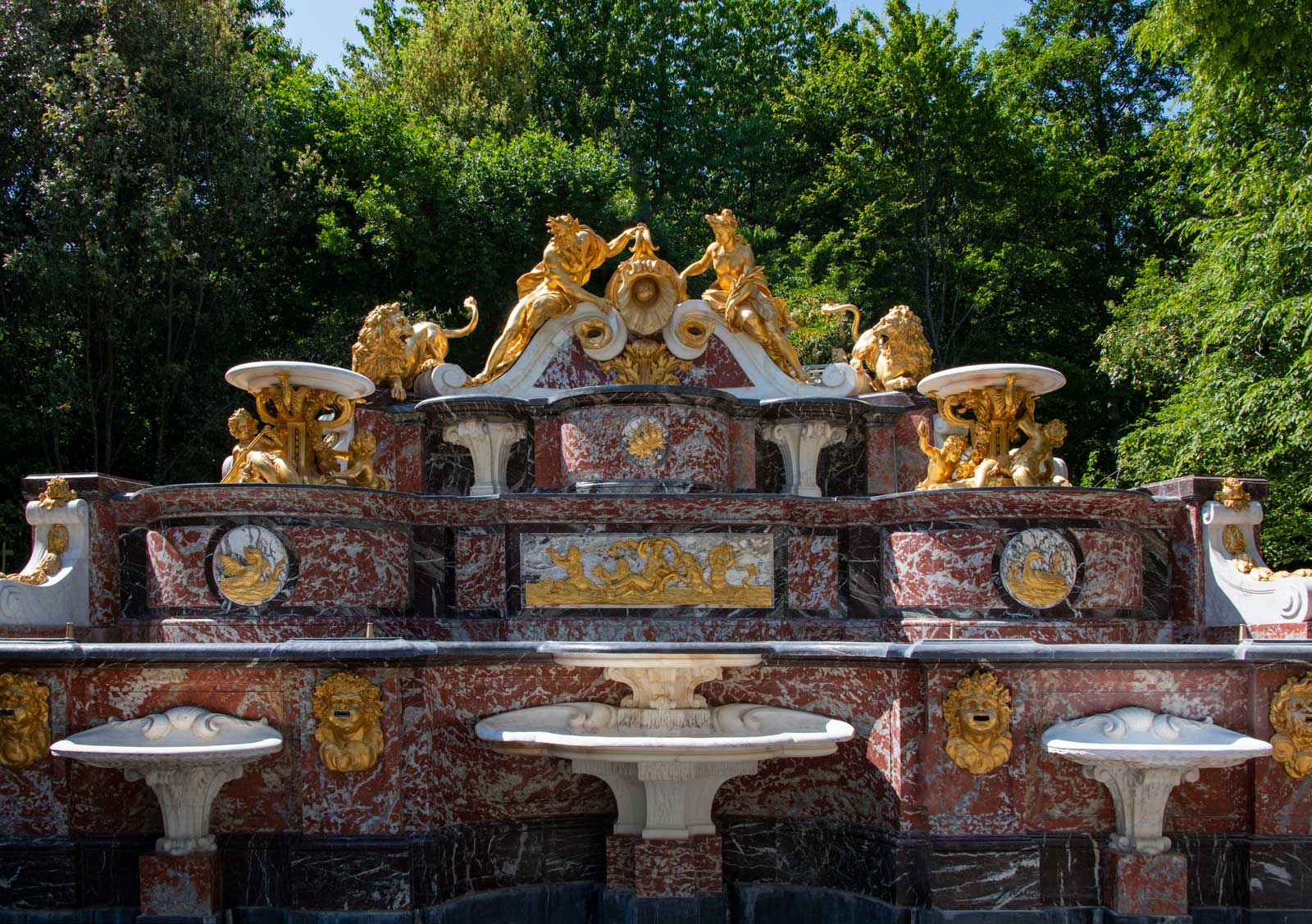
Café Streetaly
A Streetaly coffee cart offers coffees, iced coffees and Italian sweets, all made from coffee roasted in the Aosta Valley.
It is located at the Grand Trianon, every day from 12pm to 5pm in low season (November to March) and from 12pm to 6pm in high season (April to October).
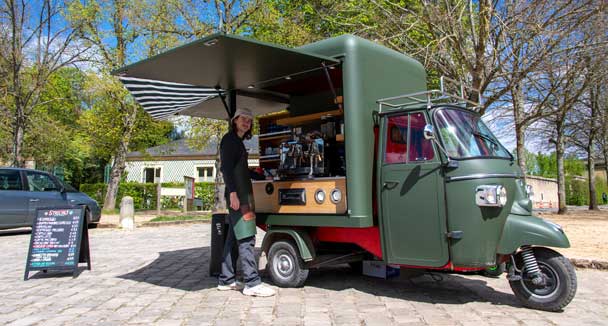
The Perfumer’s Garden
At the centre of the Estate of Trianon, this new garden features hundreds of flower essences, telling the story of the history of perfume and its uses at the Court of Versailles.
This garden has been developed thanks to the patronage of Maison Francis Kurkdjian.
Access by guided tour/workshop only.
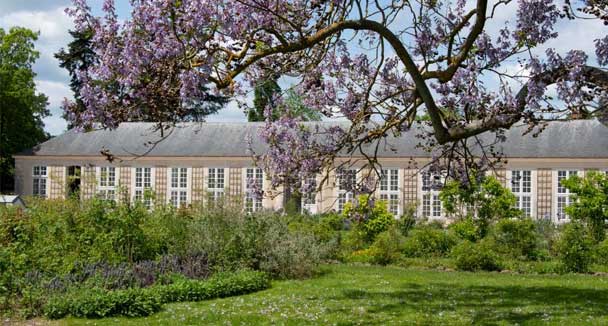
Audioguide - Grand Trianon
The audioguide collection desk is located at the entrance after the security check: every day when the Grand Trianon opens and 30 minutes before the last admission, i.e. 5.30pm in high season and 4.30pm in low season.
The audioguides are returned at the end of the tour, at the exit of the Grand Trianon, Petit Trianon and the Estate of Marie-Antoinette.
The audioguide is available in 3 languages: French, English and Spanish.
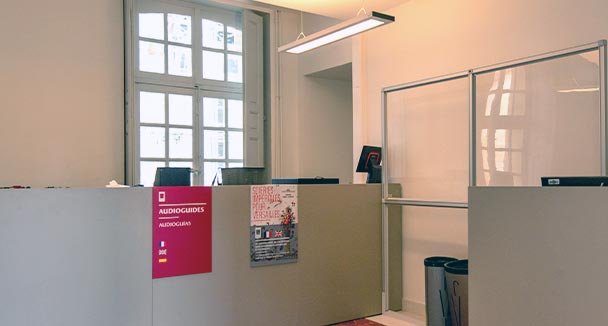
Audioguide - Petit Trianon
The audioguide collection desk is located at the entrance after the security check: every day when the Petit Trianon opens and 30 minutes before the last admission, i.e. 5.30pm in high season and 4.30pm in low season.
The audioguides are returned at the end of the tour, at the exit of the Petit Trianon, the Grand Trianon and the Estate of Marie-Antoinette.
The audioguide is available in 3 languages: French, English and Spanish.
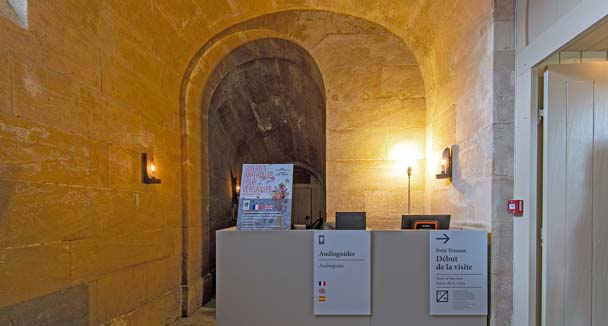
How do I get there from the town?
Saint-Anthony Gate
Due to the anti-terrorist security plan, visitors with large baggage items are not admitted on the domain (exceeding 55x35x20 cm).
Located on the D186 arriving from le Chesnay, the Saint Anthony Gate gives access to the Estate park:
On foot or bicycle :
This gate is open daily from 7:00AM to 7:30PM (from April to October). Last admission: 7PM
This gate is open daily from 8:00AM to 6:00PM (from November to March). Last admission: 5:30PM
Vehicle access :
High season (April to October): weekends and public holidays, 9am - 5.50pm
Low season (November to March): weekends and public holidays, 9.00am - 4.50pm
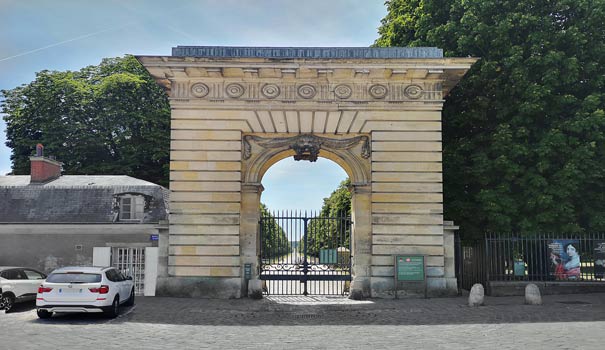
The Queen’s Gate
Access times on foot or by bike:
Vehicle access :
- Car : €12
- Bus : €30
- Montocycle : €3
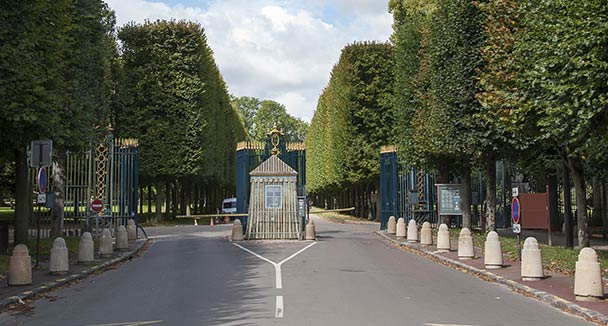
The Queen’s Gate
Access times on foot or by bike:
Vehicle access :
- Car : €12
- Bus : €30
- Montocycle : €3

The Grand Trianon Entrance
The entrance to the Grand Trianon is on the left as you face the building.
Open from midday to 6.30pm during high season (April to October) and from midday to 5.30pm during low season (November to March). Gardens open until 7.30pm during high season and until 6pm during low season.
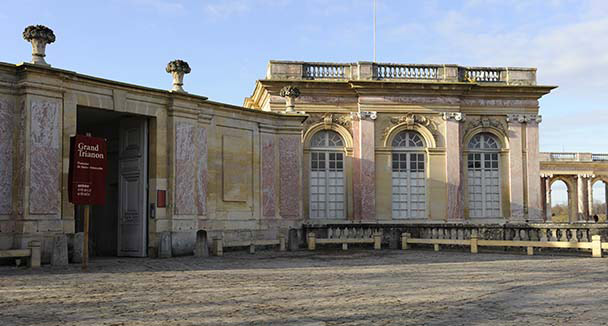
Grand Trianon Car Park
Parking is available at the parking of Grand Trianon (payable at the Queen's Gate and Saint Anthony's Gate) for cars only.
Some spaces for disabled visitors are available.

Ticket Office - Grand Trianon
The ticket office is located inside the Grand Trianon, through the archway.

Petit Trianon Entrance (Via The Swiss Guard House)
For guided tours only (for other visits, access through the Grand Trianon)
The entrance is on the left of the Petit Trianon gate.
Open from midday to 6.30pm during high season (April to October) and from midday to 5.30pm during low season (November to March). Gardens open until 7.30pm during high season and until 6pm during low season.
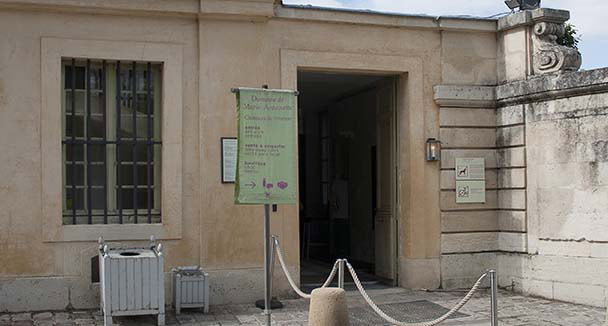
Ticket Office - Petit Trianon
The ticket office is located beyond the information desk and the courtyard.

Parking - Petit Trianon (Cars)
Some spaces for disabled visitors are available.

How do I get there from the town?
Saint-Anthony Gate
Due to the anti-terrorist security plan, visitors with large baggage items are not admitted on the domain (exceeding 55x35x20 cm).
Located on the D186 arriving from le Chesnay, the Saint Anthony Gate gives access to the Estate park:
On foot or bicycle :
This gate is open daily from 7:00AM to 7:30PM (from April to October). Last admission: 7PM
This gate is open daily from 8:00AM to 6:00PM (from November to March). Last admission: 5:30PM
Vehicle access :
High season (April to October): weekends and public holidays, 9am - 5.50pm
Low season (November to March): weekends and public holidays, 9.00am - 4.50pm

The Queen’s Gate
Access times on foot or by bike:
Vehicle access :
- Car : €12
- Bus : €30
- Montocycle : €3

The Queen’s Gate
Access times on foot or by bike:
Vehicle access :
- Car : €12
- Bus : €30
- Montocycle : €3

The Grand Trianon Entrance
The entrance to the Grand Trianon is on the left as you face the building.
Open from midday to 6.30pm during high season (April to October) and from midday to 5.30pm during low season (November to March). Gardens open until 7.30pm during high season and until 6pm during low season.

Grand Trianon Car Park
Parking is available at the parking of Grand Trianon (payable at the Queen's Gate and Saint Anthony's Gate) for cars only.
Some spaces for disabled visitors are available.

Ticket Office - Grand Trianon
The ticket office is located inside the Grand Trianon, through the archway.

Petit Trianon Entrance (Via The Swiss Guard House)
For guided tours only (for other visits, access through the Grand Trianon)
The entrance is on the left of the Petit Trianon gate.
Open from midday to 6.30pm during high season (April to October) and from midday to 5.30pm during low season (November to March). Gardens open until 7.30pm during high season and until 6pm during low season.

Ticket Office - Petit Trianon
The ticket office is located beyond the information desk and the courtyard.

Parking - Petit Trianon (Cars)
Some spaces for disabled visitors are available.

Don’t miss...
The Grand Trianon

Gardens Of The Grand Trianon
The Grand Trianon was built on the orders of Louis in 1663, and is surrounded by parterres and fountains. The laying out of the gardens was the work of Michel Le Bouteux, who also set out a number of orange trees, protected from winter weather by an ingenious moveable greenhouse.
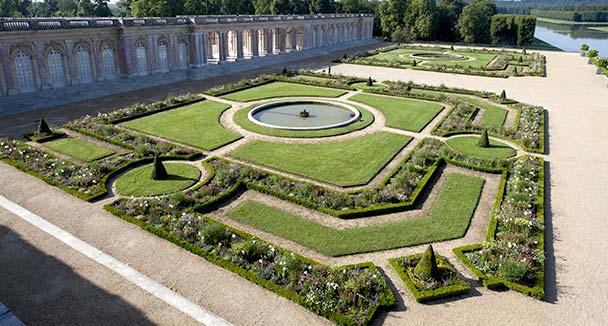
Horseshoe Fountain
Flanked by two ramps, the Horseshoe Fountain faces the secondary axis of the Grand Canal and gave access to the Grand Trianon by boat.
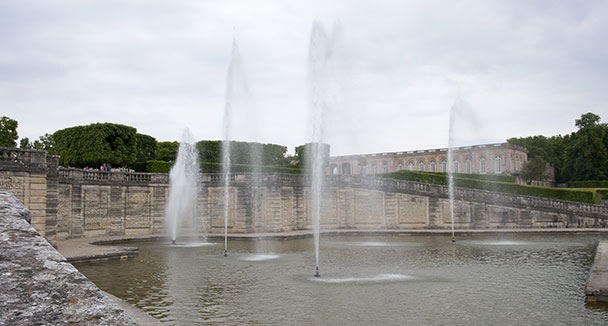
Lower Fountain
Situated in the north west axis of the Grand Trianon, and decorated with dragons by Jean Hardy; here you can see the Grand Trianon's reflection.
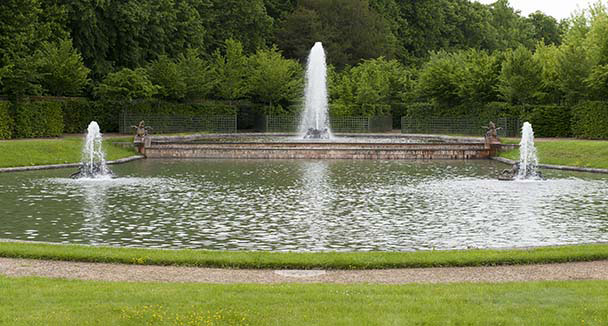
Amphitheatre
Called the Amphithéâtre or the Antiques Room, this place consists of busts copied from ancient times.
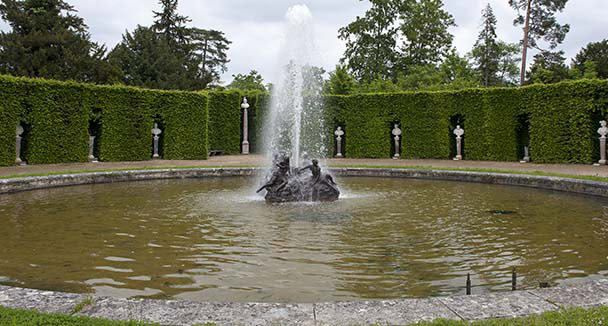
Green Rooms
The Green Groves are visible from the Bottom Fountain and were formerly decorated with statues and marbles vases.
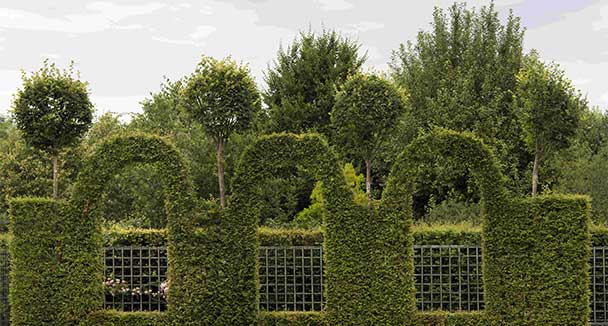
Petit Trianon
Madame de Pompadour, who wished to “relieve the king’s boredom”, was the instigator of this small palace built by Ange-Jacques Gabriel between 1763 and 1768, close to the botanical gardens and the new menagerie. To please the Marquise who was always at the height of fashion, the architect abandoned the "rocaille" style and adopted a cubist form with straight lines in accordance with the latest "Greek style" architectural trend.
Only the garden level of the Petit Trianon is accessible to disabled visitors.
The Petit Trianon is open every day except Monday. During high season, it is open from midday to 18:30 (April to October) and from midday to 17.30 during low season (November to March). In July and August, it opens exceptionally at 10am from Tuesday to Sunday. Last admission 30 minutes before closing. The gardens are open until 7:30 p.m. during high season and until 18:00 during low season.

French Garden Of The Petit Trianon
In 1749, encouraged by Madame de Pompadour, Louis XV, residing in the Grand Trianon, extended his estate by creating a new "French-style" garden characterised by geometric and symmetrical lines. The parterres were designed by the architect Ange-Jacques Gabriel and the gardens were managed by Claude Richard, who confirmed the scientific vocation of the new estate. Vegetable garden, fig trees, flowers and rare fruits completed the nursery.
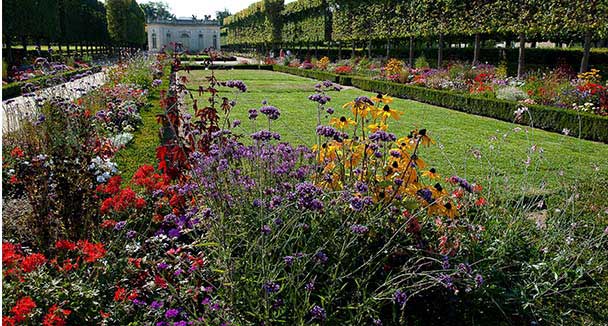
French Pavilion
This is known as the "French" pavilion as it is located at the centre of the rectilinear gardens that were referred to in this way to distinguish them from the emerging English garden trend. Built by Gabriel in 1750, it consists of a vast circular room flanked by four small rooms that served as a boudoir, "rechauffoir" (warming room), kitchen and wardrobe.
The French Pavilion can only be viewed from the exterior.
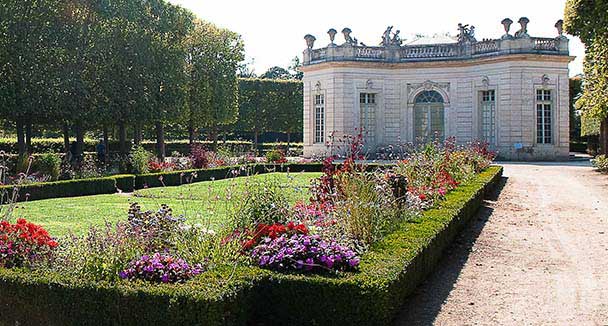
Chapel
Completed in 1773 by the architect to Louis XV, Ange-Jacques Gabriel, the chapel of the Petit Trianon was decorated in the latest neo-classical fashion, which was in vogue at the time. Inside, on the altar, is a canvas by painter Joseph-Marie Vien.
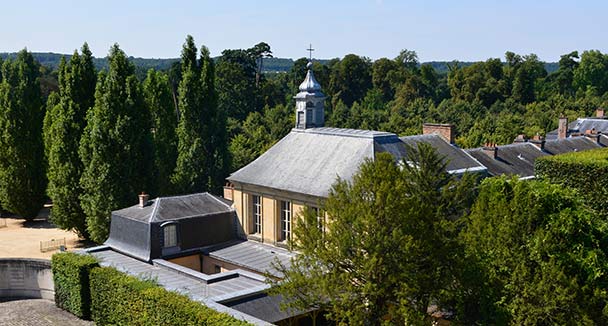
Queen's Theatre
The Queen's Theatre was a small hall where games and operas took place. It was built in 1780 by Richard Mique on the orders of Marie-Antoinette. The severe exterior contrasts with the refined interior which, through its harmonies of blue, white and gold, recalls the opera of Versailles, only smaller since it has a capacity of just one hundred people. But the greatest luxury is not in the wood-panelled room painted in a false, veined white marble and adorned with pasteboard sculptures - it lies in the machinery used for the scenery changes, which has fortunately been preserved.
The inside of the theatre can be viewed from the hall without a guide.
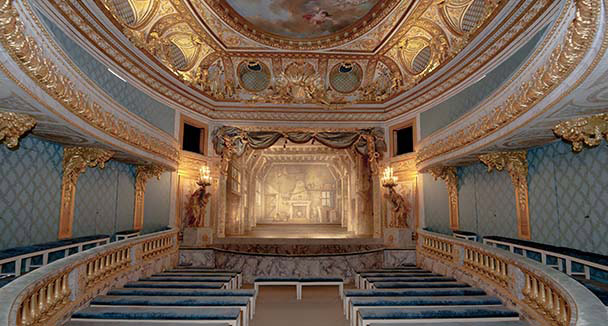
Jussieu Orangery
In 1759, at the request of Louis XV, a famous botanist called Bernard de Jussieu created a botanical garden at Trianon and had the biggest glasshouses in Europe built. Today this is called the Jussieu Orangery. With gardeners Claude and Antoine Richard, he undertook experiments on exotic or rare plants: strawberries, pineapples, tobacco, etc.

Jussieu Pavilion - Research Centre
The Palace of Versailles Research Centre focuses on research and training in relation to courtly traditions at Versailles and throughout Europe, mainly in the 17th and 18th century.
The Jussieu Pavilion is not accessible without a guide.
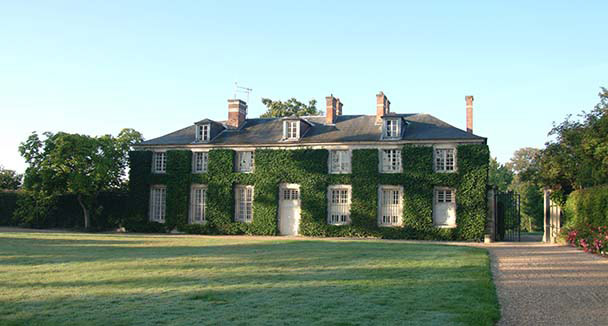
Temple Of Love
This Temple of Love, which Marie-Antoinette could see from her room in the Petit Trianon, was erected by Richard Mique in 1778 in a neo-classical style. Fully decorated in marble, this precious building is especially remarkable for the quality of the sculptures by Deschamps which ornament the Corinthian capitals, the friezes and the inside of the dome.
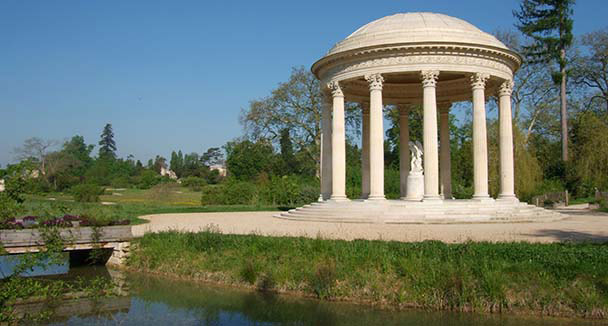
Belvedere
Dominating the lake, this charming octagonal pavilion was built by Richard Mique in 1777. It is complemented on the exterior by several sculptures by Deschamps: a fruit frieze garland once painted with colours, pediments evoking the pleasures of hunting and gardening, window imposts symbolising the four seasons.
The Belvedere can only be viewed from the exterior.
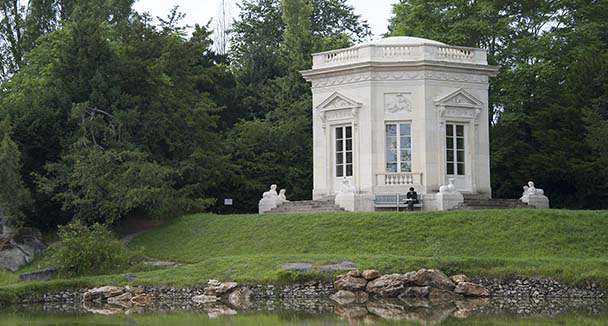
Anglo-Chinese Garden
Sacrificing the botanic garden of Louis XV, Marie-Antoinette commissioned her architect, Richard Mique, and the painter Hubert Robert to create a picturesque garden. The vogue at the time was for English-style gardens, consisting of an artificial succession of "natural" landscapes. The Queen dreamed of free nature that was not imprisoned in glasshouses or parterres.
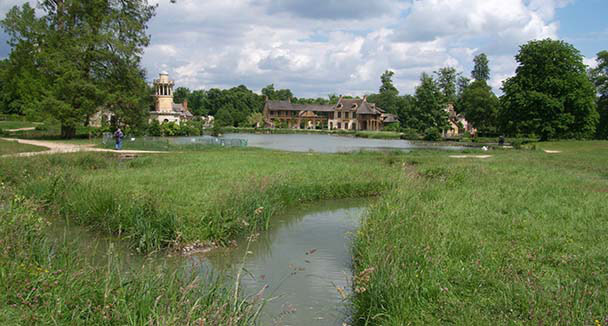
Rock
The Rock is a man-made elevation near the Belvedere. It took four years to complete, from 1778 to 1782. Thanks to a reservoir behind it, water flows into the lake in a torrent.
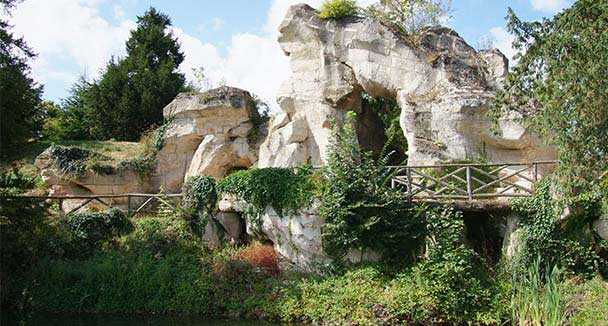
Cool Pavilion
The Cool Pavilion was built in 1751 to serve as a dining room, probably for the consumption of produce from the dairy and vegetable garden.
A number of architectural digs took place in the Pavilion Frais garden between 2006 and 2009, the results of which were used to restore this building, which was built during Louis XV's reign and destroyed in 1810.
The Cool Pavilion can only be viewed from the exterior.
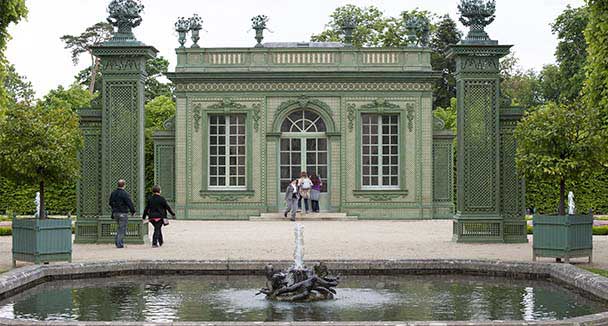
Queen’s Hamlet
Marie-Antoinette, seeking to flee the Court of Versailles, ordered the construction of her hamlet in 1783. She regularly went there to experience the charms of country life, surrounded by her lady's companions. It became a genuine farm, managed by a farmer, whose produce supplied the kitchens of the Palace.
The workshops in the Hamlet can only be viewed from the exterior.
Queen's House
The interior visit is only available on a guided tour
The largest building in the Hamlet, the Queen's House has a dining room and a games room on the ground floor, while the first floor is made up of a large living room, a small living room and a Chinese room. The building is linked to the Billiard House by a wooden gallery, decorated with white and blue faience flower pots with Marie-Antoinette's initials.
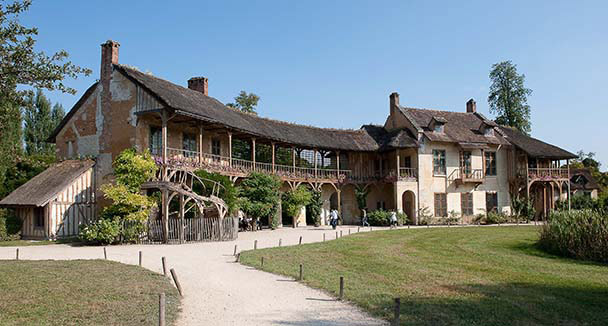
Boudoir
With its roof of reeds, dormer window, its lean-to and old stone staircase, the small Queen’s House, known as the boudoir, is made up of a living room and a wardrobe and is surrounded by a closed garden.
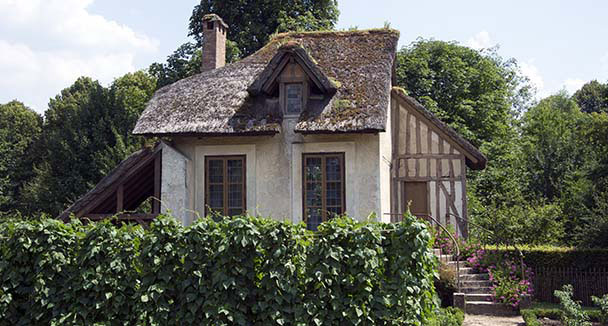
Warming Room
With its arrangement of right angles, the Warming Room is a traditional cottage that housed a large kitchen, a pantry and small offices. Dishes were brought here before being served in the dining rooms of Marie-Antoinette's Petit Trianon.
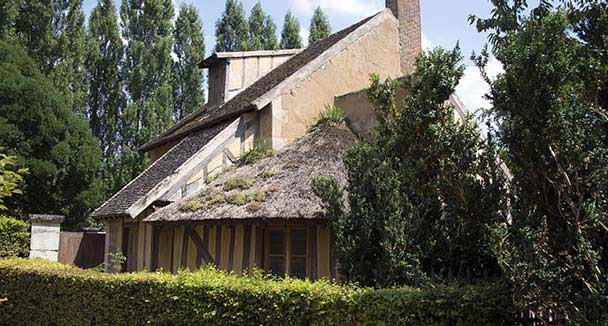
Guard House
Swiss Guard Jean Bersy, guardian of Marie-Antoinette's estate, lived in this small residence, known as the "Swiss House". One of the fences is bordered by a path covered with trellis-work arches where games of bowls took place, restored in the 20th century.
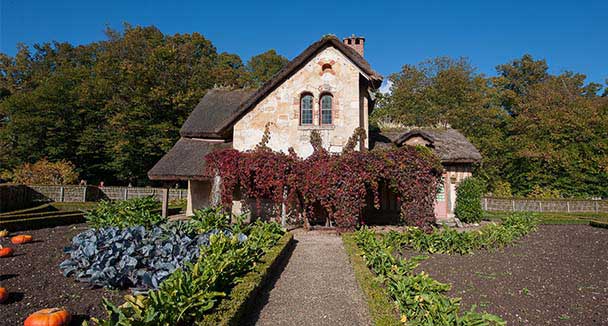
Marlborough Tower
The departure point for boat rides on the lake, the Fishery Tower, known as the Marlborough Tower, houses the material used for pike or carp fishing. Its upper portion was used as an observatory, making it possible to communicate with the Palace of Versailles using signals.
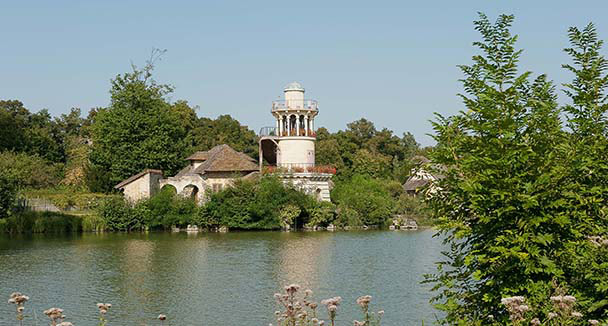
Refreshments Dairy
In the estate Dairy, Marie-Antoinette would taste the skimmed milk and churned butter. The Queen enjoyed using the dairy products from her Hamlet. Furnished with marble tables set with china, the Dairy was restored under Louis XVIII, in the 19th Century.
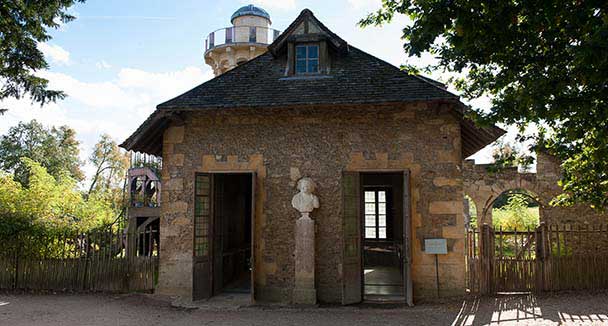
Watermill
Built at the edge of the lake in Marie-Antoinette's Hamlet, near the Marlborough Tower, the Watermilland its wheel were used to grind the grain. It also had a washing place for the use of the village.
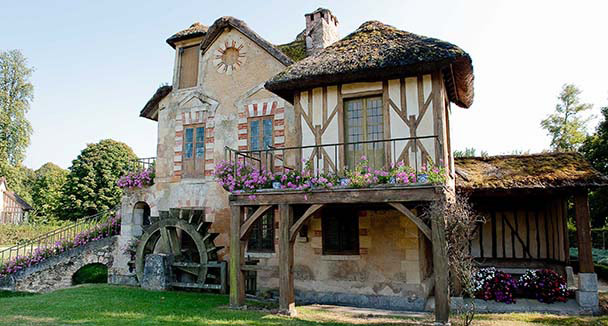
Dovecote
In Marie-Antoinette's Hamlet, next to the ballroom, the barn and the hen house which have all disappeared, the charming Dovecote still stands, built by Richard Mique in 1783. The Dovecote is located near the stone bridge which spans the carp-populated river, and has been designed in a picturesque style.
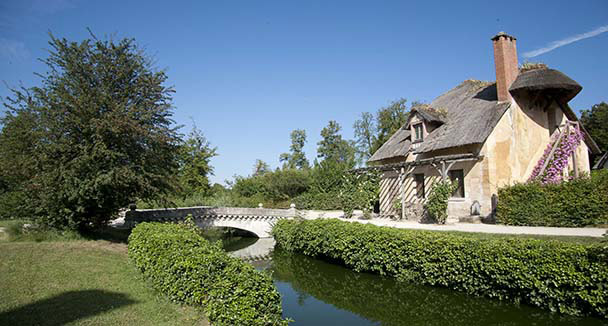
Billiard House
Linked to the Queen's House by a wooden gallery, the Billiard House hosted players in the Billiard Room, decorated with wardrobes, one for men and one for women. Upstairs is a small apartment that architect Richard Mique used when he visited the Hamlet.
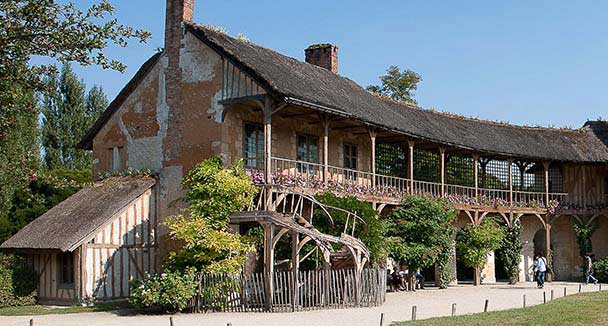
Jussieu Garden
In 1759, at the request of Louis XV, a famous botanist called Bernard de Jussieu created a botanical garden at Trianon and had the biggest glasshouses in Europe built. Today this is called the Jussieu Garden. With gardeners Claude and Antoine Richard, he undertook experiments on exotic or rare plants: strawberries, pineapples, tobacco, etc.
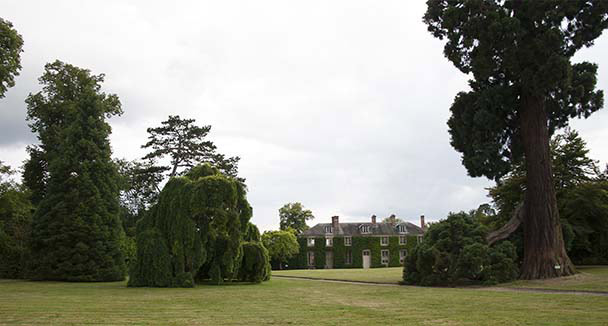
Centaur Basin
The Centaur basin, located next to General de Gaulle's former apartments, is an area comprising a fountain and a sculpture that is a 1780 copy of one of the Furietti Centaurs in Rome.
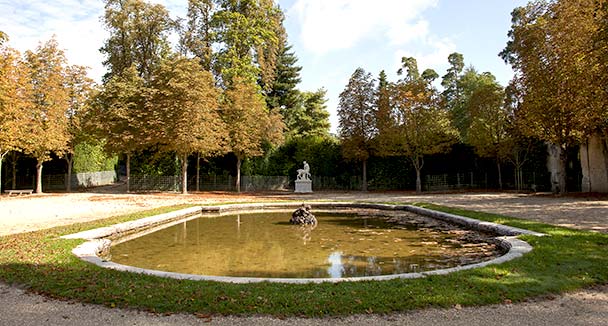
Trianon-Sous-Bois
Twenty years after being built Trianon was too small to house all of Louis XIV’s family. Shortly before his death in 1708, Jules Hardouin-Mansart built this wing, Trianon-sous-Bois, whose sober elegance ushered in the eighteenth-century style. The king’s sister-in-law, Madame Palatine, and her children were the first to occupy the group of apartments in this part of the building.
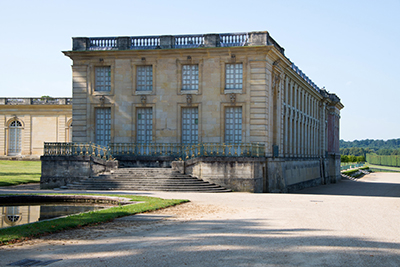
Water Sideboard Fountain

The Farm
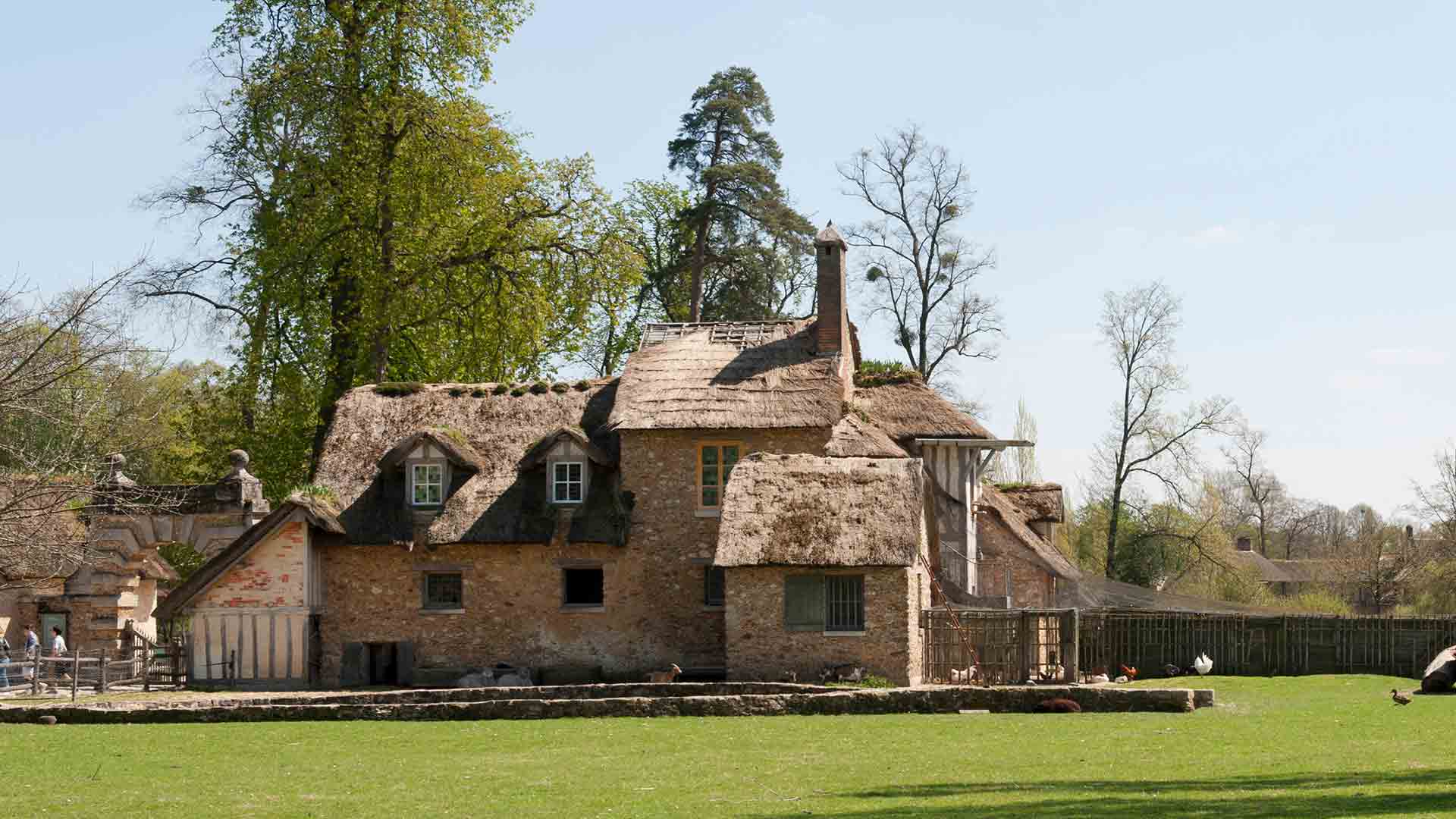
The Fountain Of The Four Nymphs
Sculpted group attributed to Jean Hardy (1653-1737) composed of nymphs sitting on rocks and holding flowers. This group was commissioned in 1706 for the gardens of Marly but later transferred to the Grand Trianon. Material : gilded lead.
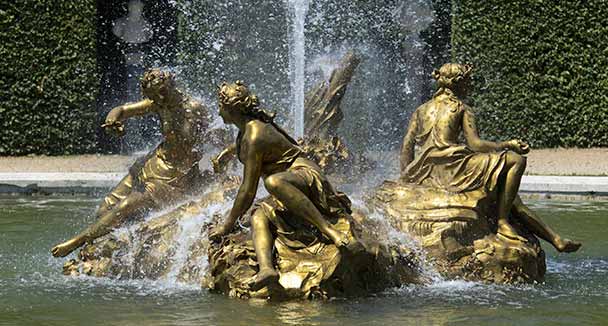
The Perfumer’s Garden
At the centre of the Estate of Trianon, this new garden features hundreds of flower essences, telling the story of the history of perfume and its uses at the Court of Versailles.
This garden has been developed thanks to the patronage of Maison Francis Kurkdjian.
Access by guided tour/workshop only.

Where can I buy a ticket?
Ticket Office - Grand Trianon
The ticket office is located inside the Grand Trianon, through the archway.

Where can i pick up my audioguide?
Audioguide - Grand Trianon
The audioguide collection desk is located at the entrance after the security check: every day when the Grand Trianon opens and 30 minutes before the last admission, i.e. 5.30pm in high season and 4.30pm in low season.
The audioguides are returned at the end of the tour, at the exit of the Grand Trianon, Petit Trianon and the Estate of Marie-Antoinette.
The audioguide is available in 3 languages: French, English and Spanish.

Audioguide - Petit Trianon
The audioguide collection desk is located at the entrance after the security check: every day when the Petit Trianon opens and 30 minutes before the last admission, i.e. 5.30pm in high season and 4.30pm in low season.
The audioguides are returned at the end of the tour, at the exit of the Petit Trianon, the Grand Trianon and the Estate of Marie-Antoinette.
The audioguide is available in 3 languages: French, English and Spanish.

Where can I get something to eat?
A coffee seller is available on the Grand Trianon parade ground.
Angelina: Terrace And Take-Away Sales
Open from 12pm to 5:30 pm
The Angelina terrace offers a sweet and savoury menu to take away or to enjoy on the spot: hot chocolate, pastries, salads, sandwiches, cold drinks and home-made ice creams. Located in the Petit Trianon and accessible without a ticket, the terrace is open from Tuesday to Sunday, from 12pm to 6:30pm in high season and from 12pm to 5.30pm in low season.

Where are the toilets located?
Toilets - Grand Trianon
There are free toilets in front of the Grand Trianon, inside the Chemin Creux pavilion.
In case of emergency, a defibrillator is available for public use. It is fully automatic and does not require any prior training.

Baby Change - Grand Trianon
There is a baby-changing table in front of the Grand Trianon, inside the Chemin Creux pavilion.
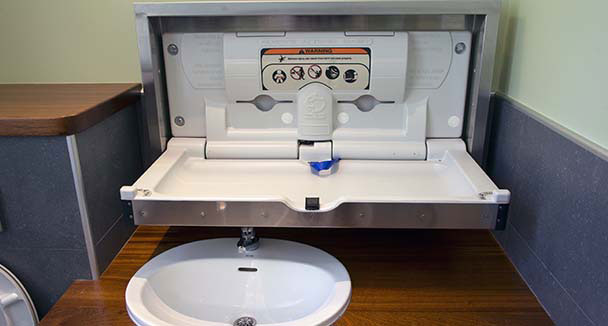
Toilets - Petit Trianon
Free toilets are located at the entrance to the Petit Trianon, beyond the information desk, in the courtyard. These toilets can be accessed without a ticket.

Toilets - Queen’s Hamlet
There are free toilets located in the Gardener's House, also called the Guard's house. These toilets are open from 1pm and are accessible to the disabled.
In case of emergency, a defibrillator is available for public use. It is fully automatic and does not require any prior training.






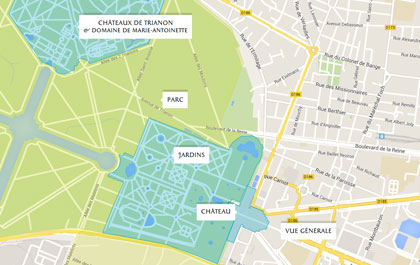
 Optimized for tablets and smartphones
Optimized for tablets and smartphones
